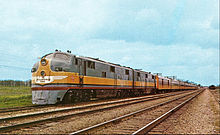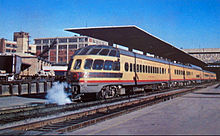Twin Cities Hiawatha
The Twin Cities Hiawatha was a luxury passenger train on the Chicago, Milwaukee, St. Paul and Pacific Railroad , which ran between Chicago and the twin cities of Minneapolis / St. Paul ("Twin Cities") ran. Hiawatha was a traditional train name of this society.
introduction
The train started operating on May 29, 1935. He covered the 660-kilometer route in just under six hours a day. Milwaukee designed new, streamlined , light express train passenger cars for the train , primarily to stand up to the competition, the Twin Cities Zephyr of the Chicago, Burlington and Quincy Railroad (CB&Q) and the Twin Cities 400 of the Chicago and North Western Railway (C&NW) .
While the CB & Q on speed rail cars and the C & NW in converted Pacific's traditional passenger cars put that Milwaukee used specifically by ALCo redesigned and by industrial designer Otto Kuhler designed steam locomotives of class A with a top speed of over 160 km / h. The two orange train sets with their distinctive arched side windows, built in the railway's own workshops, consisted of three open- plan cars , a parlor car , a “tap café” car and the famous Beavertail lounge, a pulpit car at the end of the train.
As with the Pioneer Zephyr of Burlington or the M-10000 of the Union Pacific Railroad often lined onlookers the route. Originally only five stopovers were made. The route was already equipped with driver's cab signaling in 1935 , which indicated white, green or red lights in the locomotive. When approaching a red signal, a loud whistle signal was also triggered in the driver's cab, which only stopped when the brake was applied.
successor

The success of the train had Milwaukee procure new train sets just a year later. They also had a dining car , a combined baggage car / lounge car (saloon car) and a slightly modified "Beavertail" pulpit car (four elongated windows instead of two small pretzel-shaped ones). This "1937" Hiawatha was easily distinguishable from its predecessor by a longitudinal rib below and above the now rectangular windows.
On September 19, 1938, the train was again equipped with new vehicles, the interior fittings and the entire external streamlined shape of the German-American industrial designer Otto Kuhler . The sides of the “1939” Hiawatha were now completely “ribbed” on the outside, the ribbon windows were divided into distinctive groups of three and the end car was provided with elliptical shadow plates that made it unmistakable. Due to the increased weight, Milwaukee procured six new "Baltic" steam locomotives from ALCO and classified them as class F-7 (numbers 100 to 105) for the rolling stock, which was again built in the railway's own Menomonee Valley workshops .
- Hiawatha material from 1938
From January 1939 the timetable was changed. The Twin Cities Hiawatha has been replaced by two trains, the Morning Hiawatha and the Afternoon Hiawatha . Milwaukee thus offered two excellent daytime connections between the twin cities of Minneapolis / St. Paul and Chicago. The vehicles remained the same, only now each set drove the route there and back daily.
In 1941, Milwaukee began to procure diesel locomotives for its Hiawatha trains , first an AA Set Alco DL-109, which was given the number 14, then an AA Set EMD E6, which was classified as number 15. At the same time, new passenger cars were procured. In the following years the trains were partly mixed, older vehicles were modernized and the train lengths increased to up to 15 cars , especially during the Second World War .
From 1947, parallel to the introduction of the Olympian Hiawatha , new vehicles were again procured for the train. The hallmarks of the new “Hiawatha” were the partly oval windows and circular porthole windows of the doors and the “Skytop Lounges” designed by Brooks Stevens , four observation cars with generously glazed end dome and saloon compartments with rotating seats.
In 1952, the “Milwaukee Road” introduced the “Super Dome” for the first time in the USA with observation cars, in which the transparent pulpit with panoramic windows extended the entire length of the car. The upper floor could accommodate up to 70 passengers, while the lower floor was a cocktail lounge. These six-axle cars, built by the Pullman-Standard Car Manufacturing Company, were the heaviest in the Hiawatha fleet and, like the “Skytops”, were very popular with passengers . Of the ten Superdomes delivered, six went to the Olympian Hiawatha, while the remaining four were distributed to the Morning and Afternoon Hiawathas.
- Inside views of the Super Dome
attitude
The Afternoon Hiawatha ran until January 1970, the Morning Hiawatha just under a year longer, until Amtrak largely took over long- distance passenger transport in the United States on May 1, 1971 . From then on, only the Empire Builder , which was taken over from the Great Northern Railway , operated between Chicago and the Twin Cities , but was relocated to the Milwaukee Road route.
On January 16, 1972, Amtrak brought the name Twin Cities Hiawatha back as a train service. On June 12th of that year it was combined with the North Coast Hiawatha , which ran three times a week beyond Minneapolis to Seattle . In 1978 the Twin Cities Hiawatha was replaced by the North Star , a night train from Chicago via Minneapolis to Duluth .
Three of the four Skytop lounge cars have been preserved. Vehicle 186 “Cedar Rapids” shown has been restored to its original condition and is operational. Three of the Super Dome Cars 55 and 57 to 59 have also been preserved, while Car 58 had to be scrapped in November 2009 due to rust damage.
- Skytop and Superdome cars preserved in working order
Individual evidence
- ^ Charles FA Mann: Most Powerful Diesel Ready for Rail Service. In: The Meriden Daily Journal. September 17, 1935, accessed September 23, 2012 .
- ^ Brian Solomon: Railway Masterpieces . David & Charles, 2003, p. 35 ( Google Books ).
- ↑ Tom Murray: The Milwaukee Road . Voyageur Press, 2005, pp. 87 ( Google Books ).
- ^ Steam Still Rules the Rails . In: Popular Mechanics . Vol. 64, No. 4 , October 1935, p. 512-513 ( Google Books ).
- ↑ Skytop Lounges. In: TrainWeb. Retrieved November 4, 2012 .
- ↑ Craig Sanders: Amtrak in the Heartland . Indiana University Press, 2006, ISBN 0-253-34705-X , pp. 174 .
- ^ Bruce Goldberg: Amtrak: The First Decade . Alan Books, Silver Spring (Maryland) 1981, pp. 30-31 .
- ^ Milwaukee Road "Skytops". In: TrainWeb. Retrieved November 4, 2012 .
- ↑ CMSP & P (Chicago, Milwaukee, St. Paul & Pacific) "Milwaukee Road" 'Super' domes. In: TrainWeb. Retrieved November 4, 2012 .


















